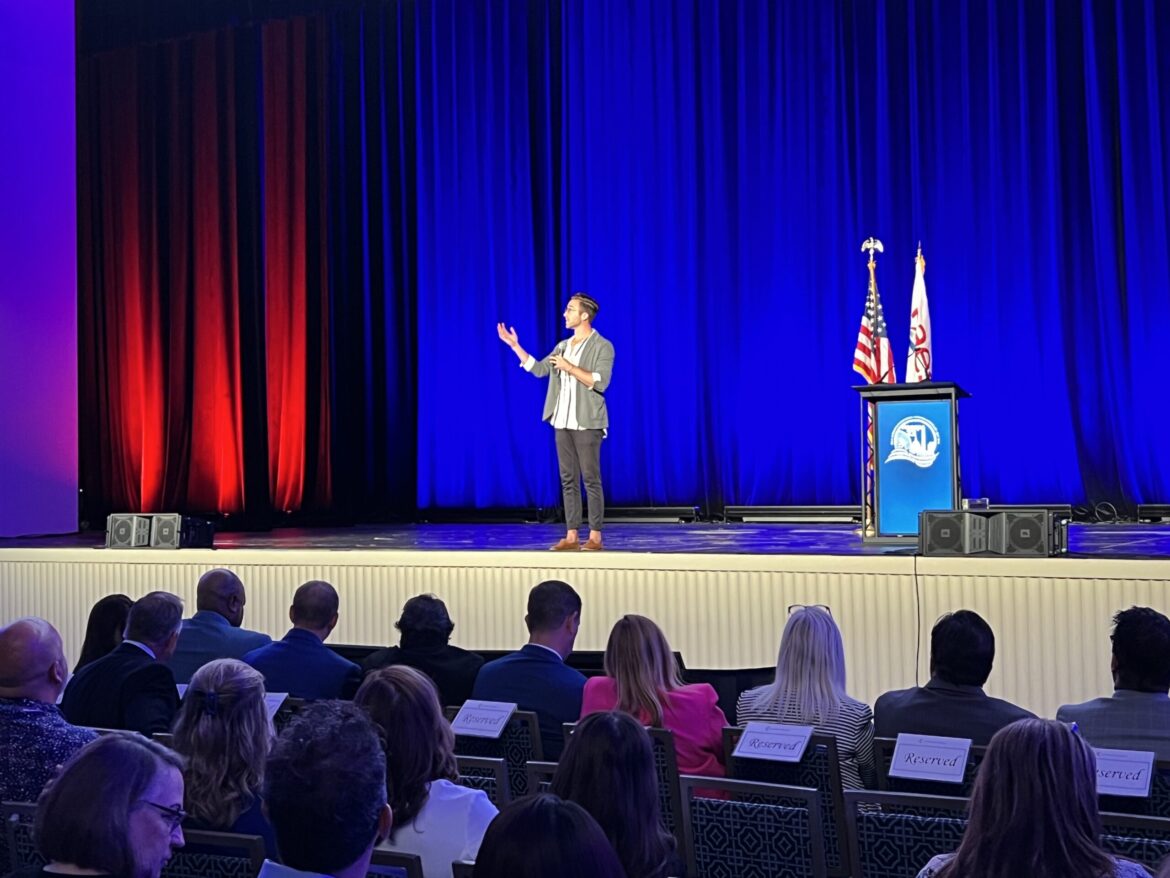Developing Kindness Through Empathy and Connections
Houston Kraft delivered a thought-provoking keynote address on using empathy and connections to grow kindness.

What were the speaker’s main messages?
Houston Kraft, cofounder of CharacterStrong, delivered a motivational, inspiring, timely, and important keynote to kick off the NAESP Pre-K-8 Principals Conference in National Harbor, Maryland. From beginning to end, every word spoken was intentional and thought-provoking, and I’m confident that everyone walked away with something they can relate to or reflect on. The first half of Kraft’s keynote was guiding educators to look at the word “kindness” in a deeper way than people usually do, including both how we think about kindness and also how we act in kindness.
He expressed that there’s a gap in what we believe in and what we actually practice with regard to kindness. Throughout the audience, there were a lot of heads nods and sounds of agreement, which was followed by him saying, “We collectively agree, but we’re not collectively good at it.” His message that “kindness is harder than it seems” and “there are natural excuses to not show deep kindness” was clear.
Kraft contrasted kindness with the word nice, explaining that nice is reactive and kindness is proactive. He went on to describe kindness as a “behavior informed by social and emotional skills.” With the preface that many schools have this hung up, he showed the well-known “Spread kindness around like confetti” poster. On the big screen, he shared differences between confetti kindness and deep kindness. Confetti kindness is cute. Deep kindness is competent. Confetti kindness is convenient. Deep kindness is courageous. Confetti kindness is random. Deep kindness is regimented. Hearing “If you don’t have time to be kind, you’re admitting that being kind is not a priority” was eye opening to many, if not all, who were listening. He encouraged us to ask ourselves what it would look like if being kind became a daily habit.
The second half of Kraft’s keynote was recognizing the importance of empathy and connections in the development of kindness. Kraft is on a mission to end those “get to know you questions” and the “name three fun facts about yourself” activities to start creating stronger and authentic connections between people. During our time together, Kraft had attendees partner up with a fellow leader to practice kindness skills. He also walked the partners through interactive games that principals can implement in their buildings to increase empathy while creating connections at the same time. The “Peanut Butter and Jelly” game included seeing a picture and sharing a word that comes to mind but also trying to stretch thinking beyond the first and obvious word. The “My Happy Place” game had attendees look at a picture, describe what made them happy and then add what else could be added to be even happier. Both of these games helped understand how someone else’s perspective is different, which aids in the increase of empathy.
Personally speaking, I met someone who felt alone in the job and shared that our discussions helped him feel better about where he was, both professionally and personally. Even though we had just met and placed together because of where we chose to sit that day, we were both vulnerable in the answers given and walked away feeling better than when we started, which was exactly what Kraft said was the goal in the beginning of the session: “We should leave people better than when we found them.” I’m sure I’m not alone in saying, mission accomplished.
What were some of the speaker’s best quotes?
- “Connection doesn’t happen by accident. It’s something we need to create. Just because we’re wired for it doesn’t mean we’re competent at it. We need to teach it.”
- “Empathy is the most important skill we can give our students. Empathy gives kindness its why.”
- “It’s entirely possible to do everything you are responsible for and still not be wonderful at your work.”
- “Education is the number one pathway to a more kind world.”
- “Throw kindness around like it’s the most meaningful resource we have.”
- “Don’t just do your work well, do it wonderful.”
What were the top ideas from the session?
- Kindness is not something on a plate; it is the plate.
- Kindness is leaving another person better than you found them.
- Kindness is not free–at the bare minimum, it costs time, energy, vulnerability, and attention.
- Kindness is external behavior informed on internal needs—skills necessary for the behaviors of kindness.
- There are three things needed to activate kindness in our schools so students can show up and learn—clarity, competence, and consistency. It’s not just how to be a good student but also how to be good people in the world.
- A high-leverage skill we can teach in education is empathy, and the first component of empathy that we have the ability to teach in classrooms is sharing.
- The “to-be” list is even more important than a person’s “to-do” list.
- We are not human beings, we are human becomings.
What is one strategy that you will implement immediately?
There is more than one thing that can be easily implemented:
- Make kindness a habit.
- Ask “What was the emotional experience of my staff last year?”
- Write and prioritize a “to-be” list with intentional actions.
What is one idea you want to learn more about?
The mental and physical effects loneliness has on the human body.
What is one strategy that will help you with instructional leadership?
- Act as the head coach of a professional sports team. Invest in the development of your educators and consistently communicate the message that you are dedicated to their growth and in the school. Communicate, train, monitor and support your teachers through changes.
- Teachers grow through correct training, which is ongoing, small bite training over consistent and aligned topics over multiple sessions throughout the year, ideally every 3-4 weeks. Focus Professional Development on the fundamentals of teaching- what do all teachers need? For example: pedagogy, classroom management, building relationships, data analysis, lesson planning.
What are resources you will check out?
- Deep Kindness: Revolutionary Guide for the Way We Think, Talk, and Act in Kindness by Houston Kraft
- The War for Kindness by Jamil Zaki
- Other games he mentioned to teach connections: “BrainStorm” and “Lighting” and “Top Three”
- Kraft’s The Wall Street Journal article, “Are You as Busy as You Think?”
I can’t wait to tell my teachers about these ideas:
- Kraft’s “management” of the audience: standing front to front, back to back, side to side. The different positions are perfect for active listening and preventing students from talking while giving time for reflection.
- How to facilitate and create meaningful opportunities for interpersonal growth in the classroom. “A classroom that understands each other better takes better care of each other.”
- Games that create and teach meaningful connections between students and/or adults:
- Peanut Butter and Jelly: What word do you think of when you see an image?
- My Happy Place: What makes you happy in the picture and what would you add to the photo to make you even happier?
What is a relevant or surprising stat you learned?
- When asked, over 80 percent of adults would rather see their children be happy and kind over high performing, yet children believed that adults would rather them get good grades than be good people.
- The average adult in the U.S. can only name 3-4 basic human emotions (mad, sad, glad, and afraid).
- 1 out of every 2 people would describe themselves as being lonely.
- Loneliness is worse for a person’s health than smoking a pack a day.
- 73 percent of Generation Z would describe themselves as sometimes or always feeling alone.
- 45 percent of a person’s day is a habit.
Notes by Tara Falasco, principal of Blue Point Elementary School in Blue Point, New York.




